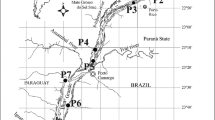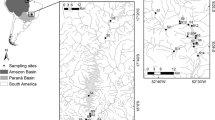Abstract
Different processes, including ecological drift, environmental changes, and biotic homogenization, can explain variation in temporal beta diversity. Here, we aimed to analyze the temporal beta diversity of zooplankton communities along the longitudinal axis of a reservoir using two analytical approaches. As for the first approach, we predicted that that beta diversity would be positively correlated with limnological variability. We used multiple samples-based metrics to estimate beta diversity among 62 sampling months at six sampling sites; after, we correlated these metrics with within-site temporal variability in limnological factors. As for the second approach, we predicted that between-months variation in community composition would be positively correlated with time lags and between-months environmental distances. Considering the multiple samples approach, we did not detect a significant relationship between temporal beta diversity and variability in limnological factors. Between-months beta diversity was unrelated to between-months differences in limnological and hydrological factors. Only temporal lags were significantly correlated with between-months beta diversity. Beta diversity and species richness were substantially highest at the lotic zone of the reservoir. Our results indicate that temporal beta diversity tends to be highly unpredictable and that most of the taxa contributing to the regional diversity of the reservoir disperse via its lotic region.






Similar content being viewed by others
References
Almeida-Neto M, Guimarães P, Guimarães PRJ, Loyola RD, Ulrich W (2008) A consistent metric for nestedness analysis in ecological systems: reconciling concept and measurement. Oikos 117:1227–1239
Anderson MJ (2006) Distance-based tests for homogeneity of multivariate dispersions. Biometrics 62:245–253
Anderson MJ, Ellingsen KE, McArdle BH (2006) Multivariate dispersion as a measure of beta diversity. Ecol Lett 9:683–693
Anderson MJ, Crist TO, Chase JM, Vellend M, Inouye BD, Freestone AL, Sanders NJ, Cornell HV, Comita LS, Davies KF, Harrison SP, Kraft NJB, Stegen JC, Swenson NG (2011) Navigating the multiple meanings of β diversity: a roadmap for the practicing ecologist. Ecol Lett 14:19–28
Astorga A, Death R, Death F, Paavola R, Chakraborty M, Muotka T (2014) Habitat heterogeneity drives the geographical distribution of beta diversity: the case of New Zealand stream invertebrates. Ecol Evol 4:2693–2702
Baselga A (2010) Partitioning the turnover and nestedness components of beta diversity. Glob Ecol Biogeogr 19:134–143
Baselga A (2013) Multiple site dissimilarity quantifies compositional heterogeneity among several sites, while average pairwise dissimilarity may be misleading. Ecography 36:124–128
Baselga A, Orme CDL (2012) betapart: an R package for the study of beta diversity. Methods Ecol Evol 3:808–812
Baselga A, Jiménez-Valverde A, Niccolini G (2007) A multiple-site similarity measure independent of richness. Biol Let 3:642–645
Bini LM, Landeiro VL, Padial AA, Siqueira T, Heino J (2014) Nutrient enrichment is related to two facets of beta diversity for stream invertebrates across the United States. Ecology 95:1569–1578
Bozelli RL, Thomaz SM, Padial AA, Lopes PM, Bini LM (2015) Floods decrease zooplankton beta diversity and environmental heterogeneity in an Amazonian floodplain system. Hydrobiologia 753:233–241
Branco CWC, Kozlowsky-Suzuki B, Sousa-Filho IF, Guarino AWS, Rocha RJ (2009) Impact of climate on the vertical water column structure of Lajes Reservoir (Brazil): a tropical reservoir case. Lakes Reserv Res Manag 14:175–191
Brown BL (2007) Habitat heterogeneity and disturbance influence patterns of community temporal variability in a small temperate stream. Hydrobiologia 586:93–106
Brown BL, Swan CM (2010) Dendritic network structure constrains metacommunity properties in riverine ecosystems. J Anim Ecol 79:571–580
Brownstein G, Steel JB, Porter S, Gray A, Wilson C, Wilson PG, Wilson JB (2012) Chance in plant communities: a new approach to its measurement using the nugget from spatial autocorrelation. J Ecol 100:987–996
Chase JM, Kraft NJB, Smith KG, Vellend M, Inouye BD (2011) Using null models to disentangle variation in community dissimilarity from variation in α-diversity. Ecosphere 2:1–11
Collins SL, Micheli F, Hartt L (2000) A method to determine rates and patterns of variability in ecological communities. Oikos 91:285–293
De Bie T, De Meester L, Brendonck L, Martens K, Goddeeris B, Ercken D, Hampel H, Denys L, Vanhecke L, Van der Gucht K, Van Wichelen J, Vyverman W, Declerck SAJ (2012) Body size and dispersal mode as key traits determining metacommunity structure of aquatic organisms. Ecol Lett 15:740–747
Dornelas M, Gotelli NJ, McGill B, Shimaszu H, Moyes F, Sievers C, Magurran AE (2014) Assemblage time series reveal biodiversity change but not systematic loss. Science 344:296–299
Dray S, Legendre P, Blanchet G (2009) packfor: Forward selection with permutation (canoco p.46). R package versio n0.0-7/r58. http://R-Forge.R-project.org/projects/sedar/
Goslee SC, Urban DL (2007) The ecodist package for dissimilarity-based analysis of ecological data. J Stat Softw 22:1–19
Gotelli NJ, Colwell RK (2001) Quantifying biodiversity: procedures and pitfalls in the measurement and comparison of species richness. Ecol Lett 4:379–391
Gray DK, Arnott SE (2012) The role of dispersal levels, Allee effects and community resistance as zooplankton communities respond to environmental change. J Appl Ecol 49:1216–1224
Hatosy SM, Martiny JBH, Sachdeva R, Steele J, Fuhrman JA, Martiny AC (2013) Beta diversity of marine bacteria depends on temporal scale. Ecology 94:1898–1904
Heino J, Grönroos M, Ilmonen J, Karhu T, Niva M, Paasivirta L (2013) Environmental heterogeneity and beta diversity of stream macroinvertebrate communities at intermediate spatial scales. Freshw Sci 32:142–154
Heino J, Melo AS, Bini LM (2015a) Reconceptualising the beta diversity-environmental heterogeneity relationship in running water systems. Freshw Biol 60:223–235
Heino J, Melo AS, Siqueira T, Soininen J, Valanko S, Bini LM (2015b) Metacommunity organisation, spatial extent and dispersal in aquatic systems: patterns, processes and prospects. Freshw Biol 60:845–869
Hillebrand H, Soininen J, Snoeijs P (2010) Warming leads to higher species turnover in a coastal ecosystem. Glob Change Biol 16:1181–1193
Jones NT, Gilbert B (2018) Geographic signatures in species turnover: decoupling colonization and extinction across a latitudinal gradient. Oikos 127:507–517
Korhonen JJ, Soininen J, Hillebrand H (2010) A quantitative analysis of temporal turnover in aquatic species assemblages across ecosystems. Ecology 91:508–517
Larson CA, Passy SI (2013) Rates of species accumulation and taxonomic diversification during phototrophic biofilm development are controlled by both nutrient supply and current velocity. Appl Environ Microbiol 79:2054–2060
Legendre P, Anderson MJ (1999) Distance-based Redundancy Analysis: testing multispecies responses in multifactorial ecological experiments. Ecol Monogr 69:1–24
Legendre P, Fortin MJ (1989) Spatial pattern and ecological analysis. Vegetatio 80:107–138
Legendre P, Legendre LF (2012) Numerical ecology. Elsevier, New York
Legendre P, Borcard D, Peres-Neto PR (2005) Analyzing beta diversity: partitioning the spatial variation of community composition data. Ecol Monogr 75:435–450
Leibold MA, Holyoak M, Mouquet N, Amarasekare P, Chase JM, Hoopes MF, Holt RD, Shurin JB, Law R, Tilman D, Loreau M, Gonzalez A (2004) The metacommunity concept: a framework for multi-scale community ecology. Ecol Lett 7:601–613
Lichstein JW (2007) Multiple regression on distance matrices: a multivariate spatial analysis tool. Plant Ecol 188:117–131
Lodi S, Velho LFM, Carvalho P, Bini LM (2014) Patterns of zooplankton population synchrony in a tropical reservoir. J Plankton Res 36:966–977
Lopes VG, Branco CWC, Kozlowsky-Suzuki B, Sousa-Filho IF, Souza LC, Bini LM (2017) Predicting temporal variation in zooplankton beta diversity is challenging. PLoS One 12:e0187499
Marzolf GR (1990) Reservoirs as environments for zooplankton. In: Thornton K, Kimmel BL, Payne FE (eds) Reservoir limnology: ecological perspectives. Wiley, New York, pp 195–208
McGill BJ, Dornelas M, Gotelli NJ, Magurran AE (2015) Fifteen forms of biodiversity trend in the Anthropocene. Trends Ecol Evol 30:104–113
McKinney ML, Lockwood JL (1999) Biotic homogenization: a few winners replacing many losers in the next mass extinction. Trends Ecol Evol 14:450–453
Oksanen J, Blanchet FG, Kindt R, Legendre P, Minchin PR, O’Hara RB, Simpson GL, Solymos P, Stevens MHH, Szoecs E, Wagner H (2017) vegan: Community Ecology Package. R package version 2.0-9
Olden JD, Poff NL (2003) Toward a mechanistic understanding and prediction of biotic homogenization. Am Nat 162:442–460
Padial AA, Ceschin F, Declerck SAJ, De Meester L, Bonecker CC, Lansac-Tôha FA, Rodrigues L, Rodrigues LC, Train S, Velho LFM, Bini LM (2014) Dispersal ability determines the role of environmental, spatial and temporal drivers of metacommunity structure. PLoS One 9:e111227
Pauly D (1995) Anecdotes and the shifting baseline syndrome of fisheries. Trends Ecol Evol 10:430
Peres-Neto PR, Legendre P, Dray S, Borcard D (2006) Variation partitioning of species data matrices: estimation and comparison of fractions. Ecology 87:2614–2625
Raup DM, Crick RE (1979) Measurement of faunal similarity in paleontology. J Paleontol 53:1213–1227
R Core Team (2013) R: a language and environment for statistical computing. R Foundation for Statistical Computing, Vienna, Austria. http://www.R-project.org/
Santos JB, Silva LH, Branco CW, Huszar VL (2016) The roles of environmental conditions and geographical distances on the species turnover of the whole phytoplankton and zooplankton communities and their subsets in tropical reservoirs. Hydrobiologia 764:171–186
Scheffer M (1990) Multiplicity of stable staes in freshwater systems. Hydrobiologia 200:475–486
Shimadzu H, Dornelas M, Magurran AE (2015) Measuring temporal turnover in ecological communities. Methods Ecol Evol 6:1384–1394
Siqueira T, Roque F, Trivinho-Strixino S (2008) Phenological patterns of neotropical lotic chironomids: is emergence constrained by environmental factors? Austral Ecol 33:902–910
Smol JP et al (2005) Climate-driven regime shifts in the biological communities of Arctic lakes. Proc Natl Acad Sci USA 102:4397–4402
Soininen J, Heino J, Wang J (2018) A meta-analysis of nestedness and turnover components of beta diversity across organisms and ecosystems. Glob Ecol Biogeogr 27:96–109
Straile D, Jochimsen MC, Kümmerlin R (2013) The use of long-term monitoring data for studies of planktonic diversity: a cautionary tale from two Swiss lakes. Freshw Biol 58:1292–1301
Tisseuil C, Leprieur F, Grenouillet G, Vrac M, Lek S (2012) Projected impacts of climate change on spatio-temporal patterns of freshwater fish beta diversity: a deconstructing approach. Glob Ecol Biogeogr 21:1213–1222
Ulrich W, Almeida-Neto M (2012) On the meanings of nestedness: back to the basics. Ecography 35:865–871
Vellend M, Srivastava DS, Anderson KM, Brown CD, Jankowski JE, Kleynhans EJ, Kraft NJB, Letaw AD, Macdonald AAM, Maclean JE, Myers-Smith IH, Norris AR, Xue X (2014) Assessing the relative importance of neutral stochasticity in ecological communities. Oikos 123:1420–1430
Zaccarelli N, Bolnick DI, Mancinelli G (2013) RInSp: an R package for the analysis of individual specialization in resource use. Methods Ecol Evol 4:1018–1023
Acknowledgements
The authors wish to thank Light Energia S.A. for financial and logistic support in carrying out this study. We are also thankful to Coordenação de Aperfeiçoamento de Pessoal de Nível Superior (CAPES) for the scholarship provided to Vanessa G. Lopes. Work by L. M. Bini have been continuously supported by CNPq Productivity Grants and is developed in the context of National Institutes for Science and Technology (INCT) in Ecology, Evolution and Biodiversity Conservation, supported by MCTIC/CNPq (proc. 465610/2014-5) and FAPEG. Thanks to two anonymous reviewers for their helpful comments.
Author information
Authors and Affiliations
Corresponding author
Additional information
Handling Editor: Munemitsu Akasaka.
Electronic supplementary material
Below is the link to the electronic supplementary material.
Rights and permissions
About this article
Cite this article
Lopes, V.G., Branco, C.W.C., Kozlowsky-Suzuki, B. et al. Zooplankton temporal beta diversity along the longitudinal axis of a tropical reservoir. Limnology 20, 121–130 (2019). https://doi.org/10.1007/s10201-018-0558-y
Received:
Accepted:
Published:
Issue Date:
DOI: https://doi.org/10.1007/s10201-018-0558-y




